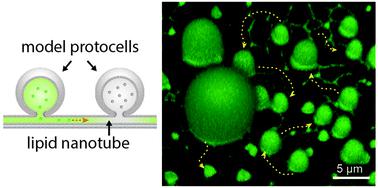Our official English website, www.x-mol.net, welcomes your
feedback! (Note: you will need to create a separate account there.)
Transport among protocells via tunneling nanotubes
Nanoscale ( IF 5.8 ) Pub Date : 2022-06-13 , DOI: 10.1039/d2nr02290g Ingrid Jin Schanke 1 , Lin Xue 1 , Karolina Spustova 1 , Irep Gözen 1
Nanoscale ( IF 5.8 ) Pub Date : 2022-06-13 , DOI: 10.1039/d2nr02290g Ingrid Jin Schanke 1 , Lin Xue 1 , Karolina Spustova 1 , Irep Gözen 1
Affiliation

|
We employ model protocell networks for evaluation of molecular transport through lipid nanotubes as potential means of communication among primitive cells on the early Earth. Network formation is initiated by deposition of lipid reservoirs onto a SiO2 surface in an aqueous environment. These reservoirs autonomously develop into surface-adhered protocells interconnected via lipid nanotubes while encapsulating solutes from the ambient buffer. We observe the uptake of DNA and RNA, and their diffusive transport between the lipid compartments via the interconnecting nanotubes. By means of an analytical model we determine key physical parameters affecting the transport, such as nanotube diameter and compartment size. We conclude that nanotube-mediated transport could have been a possible pathway of communication between primitive cells on the early Earth, circumventing the necessity for crossing the membrane barrier. We suggest this transport as a feasible means of RNA and DNA exchange under primitive prebiotic conditions, possibly facilitating early replication.
中文翻译:

通过隧道纳米管在原始细胞之间传输
我们使用模型原始细胞网络来评估通过脂质纳米管的分子运输,作为早期地球上原始细胞之间潜在的通信手段。网络的形成是通过脂质储库在水性环境中的 SiO 2表面上的沉积来启动的。这些水库自主地发展成表面粘附的原始细胞,通过脂质纳米管相互连接,同时封装来自环境缓冲液的溶质。我们观察 DNA 和 RNA 的摄取,以及它们在脂质区室之间的扩散运输互连的纳米管。通过分析模型,我们确定了影响传输的关键物理参数,例如纳米管直径和隔室尺寸。我们得出结论,纳米管介导的运输可能是早期地球上原始细胞之间通信的一种可能途径,绕过了穿过膜屏障的必要性。我们建议将这种运输作为在原始益生元条件下进行 RNA 和 DNA 交换的可行手段,可能有助于早期复制。
更新日期:2022-06-13
中文翻译:

通过隧道纳米管在原始细胞之间传输
我们使用模型原始细胞网络来评估通过脂质纳米管的分子运输,作为早期地球上原始细胞之间潜在的通信手段。网络的形成是通过脂质储库在水性环境中的 SiO 2表面上的沉积来启动的。这些水库自主地发展成表面粘附的原始细胞,通过脂质纳米管相互连接,同时封装来自环境缓冲液的溶质。我们观察 DNA 和 RNA 的摄取,以及它们在脂质区室之间的扩散运输互连的纳米管。通过分析模型,我们确定了影响传输的关键物理参数,例如纳米管直径和隔室尺寸。我们得出结论,纳米管介导的运输可能是早期地球上原始细胞之间通信的一种可能途径,绕过了穿过膜屏障的必要性。我们建议将这种运输作为在原始益生元条件下进行 RNA 和 DNA 交换的可行手段,可能有助于早期复制。











































 京公网安备 11010802027423号
京公网安备 11010802027423号